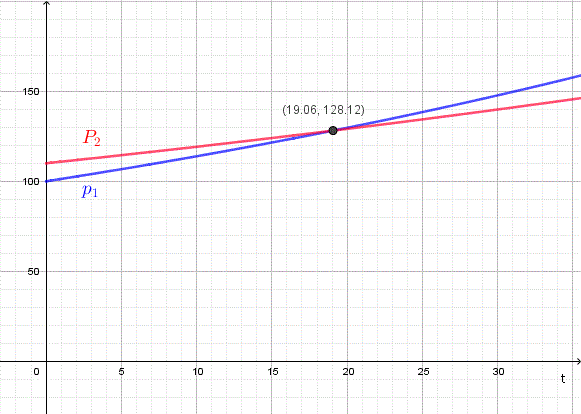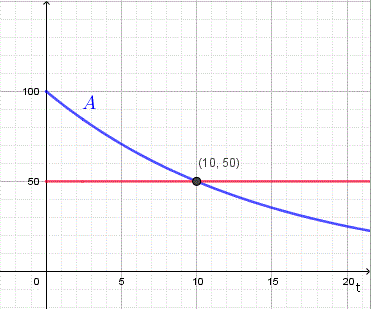Questions on exponential functions are presented along with their their detailed solutions and explanations.
Properties of the Exponential functions
For x and y real numbers:
- a x a y = a x + y
example: 2 3 25 = 2 8
- (a x) y = a x y
example: (4 2) 5 = 4 10
- (a b) x = a x b x
example: (3 × 7)3 = 33 73
- (a / b)x = a x / b x
example: (3 / 5)3 = 3 3 / 5 3
- a x / a y = a x - y
example: 5 7 / 5 4 = 5 3
Questions with Detailed Solutions and Explanations
Question 1Simplify the following expression
- Use property (1) above to write the term 2 x + 1 as 2 x × 2 in the given expression
2 x - 2 x + 1 = 2 x - 2 x × 2
- Factor 2x out
2 x - 2 x + 1 = 2 x(1 - 2)
- Simplify to obtain
2 x - 2 x + 1 = - 2 x
Question 2
Find parameters A and k so that f(1) = 1 and f(2) = 2, where f is an exponential function given by
Solution to Question 2
- Use the fact that f(1) = 1 to obtain
1 = A e k
- Now use f(2) = 2 to obtain
2 = A e 2 k
- Rewrite the above equation as
2 = A ek ek
- Use the first equation 1 = A e k obtained in the first step to rewrite 2 = A ek ek as
2 = e k
- Take the ln of both sides and simplify to obtain
k = ln (2)
- To obtain parameter A, substitute the value of k obtained in the equation 1 = A e k.
1 = A e ln(2)
- Simplify and solve for A.
A = 1/2
- Function f is given by
f(x) = (1/2) e x ln(2)
- Which can be written as
f(x) = (1/2) (e ln(2)) x
- and simplified to
f(x) = 2 x - 1
Check answer against given information
f(1) = 2 1 - 1
= 1
f(2) = 2 2 - 1
= 2
Question 3
The populations of 2 cities grow according to the exponential functions
where P1 and P2 are the populations (in thousands) of cities A and B respectively; t is the time in years such that t is positive and t = 0 corresponds to the year 2004.
When will the populations of the two cities be equal and what will be their populations? Solution to Question 3
- Let t = t' be the time when P1 and P2 are equal, this leads to the following equation in t'
100 e 0.013 t' = 110 e 0.008 t'
- Divide both side of the above equation by 100 e 0.008 t' and simplify to obtain
e 0.013 t' / e 0.008 t' = 110/100
- Use property of exponential functions a x / ay = a x - y and simplify 110/100 to rewrite the above equation as follows
e 0.013 t'- 0.008 t' = 1.1
- Simplify the exponent in the left side
e 0.005 t' = 1.1
- Rewrite the above in logarithmic form (or take the ln of both sides) to obtain
0.005 t' = ln 1.1
- Solve for t' and round the answer to the nearest unit.
t' = (ln 1.1) / 0.005.
t' is approximately equal to 19 years.
the year will be: 2004 + 19 = 2023.
- Find the populations when t = t' = 19 years. Use any of the function P1 or P2 since they are equal at t = t'
P1(t') = 100 e 0.013*19
P1(t') is approximately equal to 128 thousands.
For checking, the graphical solution to the above problem is shown below.

Question 4
The amount A of a radioactive substance decays according to the exponential function
where A0 is the initial amount (at t = 0) and t is the time in days (t ? 0). Find r, to three decimal places, if the half life of this radioactive substance is 10 days. Solution to Question 4
- At t = 10 days, the amount A of the substance would be equal to half
the initial amount A0 (definition of half life)
A 0 e r×10 = A 0 / 2
- Divide both side of the above equation by A0
e 10 r = 1 / 2
- Rewrite the above equation in logarithmic form (or take ln of both sides) to obtain
10 r = ln (1/2)
- Solve for r
r = 0.1 ln(1/2)
- Approximate r to 3 decimal places.
r is approximately equal to -0.069.
For checking, the graph of A(t) = 100 e-0.069t is shown below.
Note at t = 0 A = 100 (initial amount) and at t = 10 (half life), A is approximately equal to 50 which half the initial amount 100.

More Questions with Answers
-
Simplify the following expression
3 x + 2 × 3 x + 2 × 3 x + 1 -
Find parameters A and k so that f(1) = 3 and f(2) = 9, where f is an exponential function given by
f(x) = A e k x -
The populations of 2 cities grow according to the exponential functions
P1(t) = 120 e 0.011 t P2(t) = 125 e 0.007 t
where P1 and P2 are the populations (in thousands) of cities A and B respectively. t is the time in years such that t is positive and t = 0 corresponds to the year 2004.
When were the populations of the two cities equal and what were their populations? -
The amount A of a radioactive substance decays according to the exponential function
A(t) = A 0 e r t
where A0 is the initial amount (at t = 0) and t is the time in days (t ? 0). Find r, to three decimal places, if the the half life of this radioactive substance is 20 days.Answers to the Above Questions
-
3 x + 2 × 3 x + 2 × 3 x + 1
= 3 x + 2 × 3 x + 2 × 3 x 3
= 3 x + 2 × 3 x + 6 × 3 x
= 3 x(1 + 2 + 6)
= 9 × 3 x = 3 2 3 x = 3 x + 2 -
f(1) = A e k = 3 and f(2) = A e 2 k = 9
A e 2 k = 9 can be written as
A e k e k = 9 and we also know that A e k = 3; hence
3 e k = 9
which simplifies to
e k = 3
Take ln of both sides to solve for k and obtain
k = ln(3)
Substitute k by ln(3) in the equation A e k = 3 and simplify to obtain
A = 1. -
Find t such that
120 e 0.011 t = 125 e 0.007 t
e 0.011 t - 0.007 t = 125 / 120
Simplify and take ln of both sides
0.004 t = ln (125 / 120)
t = 10.2 years
The two populations were equal in 2004 + 10 = 2014
The population of each city in 2014 was
120 e 0.011 × 10 = 134 thousands. -
Solve for r the equation
A 0 e 20 r = A 0 / 2
Simplify
e 20 r = 1/2
Take ln of both sides
20 r = ln(1/2)
r = - 0.035
More References and Links Related to Exponential Functions
Exponential Functions.
Exponential and Logarithmic Functions.
Solve Exponential and Logarithmic Equations (self test).
Exponential and Logarithmic Functions. -